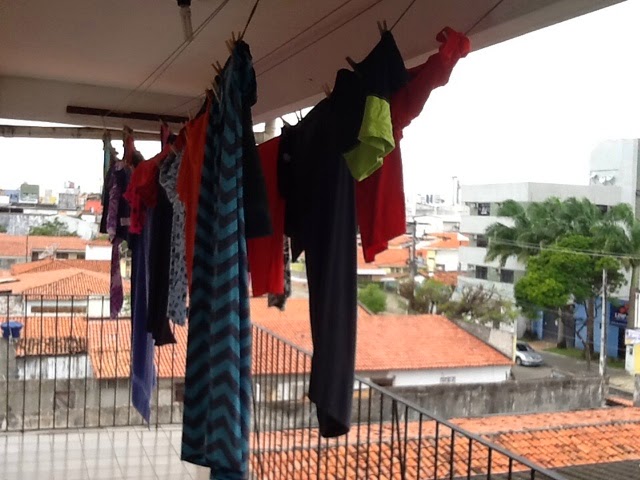My husband accuses me of what he calls strategic incompetence. Can you believe that? The very idea that I would knowingly and willfully machine wash the hand-wash-only items or forget to treat a stain or (God forbid) wash my hi-tech-fabric LuluLemon workout pants with cotton socks thus causing said LuluLemon pants to pill just so that my dear husband would grow tired of my laundry laziness and insist on doing it himself is insulting. (As insulting as it is effective.)
That said, I do have to deal with the difficulty of doing laundry in foreign countries. Not, I admit, the actual doing of it. But more the waiting for it to get done by Josh. Don't judge.
This may shock you, but most of the rest of the world does not use clothes dryers. They may have washing machines, and in some cases they may even own a dryer. But in my experience, dryers are far too energy inefficient and, therefore, too expensive to actually use. And I'm not just talking about developing countries like Thailand, Brazil, Zambia, or Malaysia. I'm talking about countries like Italy, the UK, and Japan. The rest of the world hangs their laundry to dry, whether outside on a clothesline, on a balcony, or in the living room on a drying rack.
Now before you post a bevy of comments about how you lived in wherever and had a perfectly effective dryer, thank you very much, let me say that this is my experience and the experiences of others I've talked to. I'm sure there are exceptions. For example, missionaries to Thailand, Loren and Penny Hollingsworth did have a clothes dryer - which Penny received as a gift after 26 years of living in Thailand and raising five children without one. Additionally, some American Department of Defense teachers in Okinawa who let us live in their off-base apartment one summer had a dryer that had been shipped in from the US. And we did have a tiny little all-in-one machine in London that took three hours to wash and dry one pair of jeans and eight socks.
And Brazil is no exception. We did have a very nice full-sized washer in our kitchen, but everything had to be hung to dry on the balcony of our third floor apartment at the church. Now remember, I don't do laundry, but my husband and father-in-law are champion launderers. This happened to be a really good thing since the clothes line was hung so high on the porch that I couldn't reach it without standing on a chair perilously close to the balcony railing as you can see below!
Now before you post a bevy of comments about how you lived in wherever and had a perfectly effective dryer, thank you very much, let me say that this is my experience and the experiences of others I've talked to. I'm sure there are exceptions. For example, missionaries to Thailand, Loren and Penny Hollingsworth did have a clothes dryer - which Penny received as a gift after 26 years of living in Thailand and raising five children without one. Additionally, some American Department of Defense teachers in Okinawa who let us live in their off-base apartment one summer had a dryer that had been shipped in from the US. And we did have a tiny little all-in-one machine in London that took three hours to wash and dry one pair of jeans and eight socks.
Knox gives you some perspective on the size of our washer/dryer combo thingy.
But generally, in my experience, only Americans use a dryer for laundry on a regular basis.
And Brazil is no exception. We did have a very nice full-sized washer in our kitchen, but everything had to be hung to dry on the balcony of our third floor apartment at the church. Now remember, I don't do laundry, but my husband and father-in-law are champion launderers. This happened to be a really good thing since the clothes line was hung so high on the porch that I couldn't reach it without standing on a chair perilously close to the balcony railing as you can see below!
Let me just say that it takes a very special father-in-law/daughter-in-law relationship to be comfortable letting your husband's dad hang up, take down, and fold your dirty skivvies. Thus, the lengths to which I'll go to avoid laundry. Especially when traveling. So take a moment this week to appreciate your clothes dryer! (And I'll take a moment to appreciate my husband and father-in-law.)







